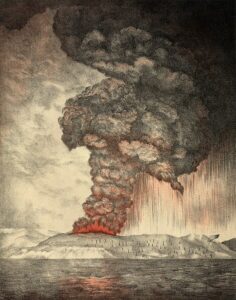Krakatoa
Krakatoa: Indonesian’s Most Infamous Volcano
Location: Krakatoa is located in the Sunda Strait between Java and Sumatra.
Date Visited: April 2023
Getting There
Touring Krakatoa (known as Krakatau in Indonesian) is definitely a logistical challenge. There are tour services available from Jakarta, but they can be offered fairly infrequently. Just conduct a Google search and you’ll find a few tour operator options. For a day trip you will have to leave Jakarta very early in the morning and expect to be gone for at least 12 hours.
I was picked up by a car directly at my apartment, then had a 3+ hour drive to the beach town of Carita on the West Java coast. At that point, I was transported by speed boat to the volcano. It’s an extremely costly excursion, particularly for one person. You’d be best off booking a spot on a larger group tour (not often available) or recruiting several people to join your private tour to share the cost to help make this expensive trip more affordable. Booking during the dry season (June-September) might be preferable as the odds of facing an afternoon thunderstorm out on the sea are lower during these months.
Why is Krakatoa infamous?

In August 1883, Krakatoa exploded with one of the largest volcanic eruptions in recent planetary history. It erupted with the force of 30,000 Hiroshima atomic bombs. The explosion could be heard as far away as Alice Springs, Australia—thousands of kilometers distant. The resulting tsunami killed over 33,000 people across nearby islands. Ash clouds blocked the sun in Jakarta for several days.
What you see on your tour
After my driver dropped me off in Carita, I was provided a nice local breakfast, then we walked to the harbor to meet the speed boat. Krakatoa is about 45 kilometers from Carita, so it takes about an hour to reach the destination. When you arrive you first see “Mother Krakatoa”, the remnants of the original volcano that originally erupted in 1883. It has been extinct for over a century, so the island that remains is lush, green, and forested, with a tall, triangular-shaped peak.
Instead, we proceeded first to “Baby Krakatoa” the short and stout volcano that formed a century ago well after the cataclysmic 1883 event. Baby Krakatoa is extremely active and was experiencing moderate-sized eruptions when I visited. We disembarked on Baby K. and climbed to the false summit (30-minute hike), from where we had an extraordinary view across to the active crater, less than one kilometer away. We also had a great view of all the surrounding islands as well.
After our return hike to the boat, we circled Baby K. by sea which afforded us other vantage points of its eruptions. We continued to Mother K. and had lunch on a secluded, pristine beach and took a brief walk through unspoiled forests. Because no one is allowed to live in the area, and because only small numbers of visitors come here, it is one of the rare beaches I’ve been to in SE Asia that wasn’t plagued by mounds of plastic and garbage washing on the shore. In fact, I was literally the only person touring the Krakatoa National Park on that day, so I had the entire park to myself. That, in itself, made it a rare and special experience.
Is Krakatoa worth a visit?
For me it was, but I really enjoy visiting volcanoes more than the average person. When one considers the cost, there are definitely other sites (and more accessible volcanoes) in Indonesia that most people would prefer for an excursion. Therefore, I would only recommend visiting Krakatoa for the most intrepid vulcanologists and historians of natural history who might want to see where one the most incredible natural events in modern history occurred. But I loved my visit, the picturesque boat trip, the active volcano, and being able to enjoy a beautiful and dramatic corner of the world all by myself, without the irritations of modern society (pollution, crowds, misbehavior) intervening.
